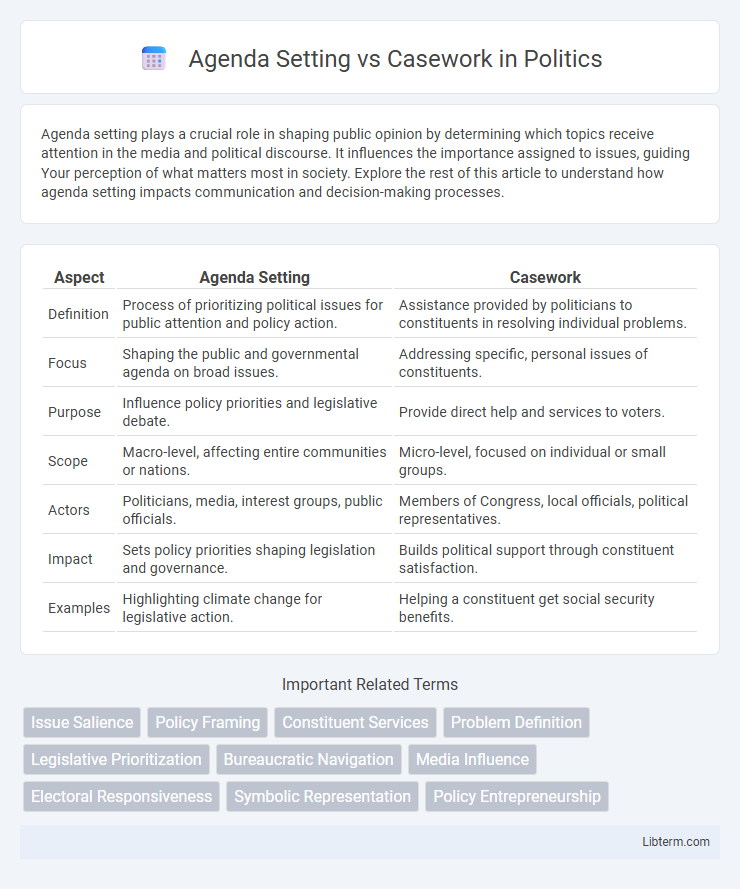Agenda setting plays a crucial role in shaping public opinion by determining which topics receive attention in the media and political discourse. It influences the importance assigned to issues, guiding Your perception of what matters most in society. Explore the rest of this article to understand how agenda setting impacts communication and decision-making processes.
Table of Comparison
| Aspect | Agenda Setting | Casework |
|---|---|---|
| Definition | Process of prioritizing political issues for public attention and policy action. | Assistance provided by politicians to constituents in resolving individual problems. |
| Focus | Shaping the public and governmental agenda on broad issues. | Addressing specific, personal issues of constituents. |
| Purpose | Influence policy priorities and legislative debate. | Provide direct help and services to voters. |
| Scope | Macro-level, affecting entire communities or nations. | Micro-level, focused on individual or small groups. |
| Actors | Politicians, media, interest groups, public officials. | Members of Congress, local officials, political representatives. |
| Impact | Sets policy priorities shaping legislation and governance. | Builds political support through constituent satisfaction. |
| Examples | Highlighting climate change for legislative action. | Helping a constituent get social security benefits. |
Introduction to Agenda Setting and Casework
Agenda setting involves the process by which public officials and media prioritize issues for governmental action, shaping the political agenda by highlighting certain problems over others. Casework refers to the direct assistance provided by elected representatives to constituents in resolving individual problems with government agencies, emphasizing personalized support and advocacy. Both agenda setting and casework are critical functions in political representation, influencing policy priorities and constituent relationships.
Defining Agenda Setting in Public Policy
Agenda setting in public policy refers to the process by which issues gain attention and priority on the governmental agenda, influencing which problems receive public and political focus. It involves the identification, framing, and promotion of specific topics to shape policymakers' decisions, often driven by media, interest groups, and political actors. Unlike casework, which addresses individual constituent concerns, agenda setting deals with broader policy issues and the collective priorities of society.
Understanding Casework in Government Operations
Casework in government operations involves direct assistance provided by elected officials and their staff to constituents facing problems with federal, state, or local agencies, ensuring personalized support for navigating bureaucratic processes. This function strengthens the relationship between representatives and their constituents by addressing individual concerns such as Social Security benefits, immigration issues, or veterans' services. Effective casework enhances governmental responsiveness and promotes trust through tangible problem-solving outcomes, distinguishing it from agenda setting, which focuses on policy prioritization and legislative initiatives.
Key Differences Between Agenda Setting and Casework
Agenda Setting primarily involves influencing public policy by determining which issues receive attention on the political stage, shaping legislative priorities and media focus. Casework concentrates on assisting individual constituents with specific problems, often related to government services or bureaucratic hurdles. The key difference lies in scope: Agenda Setting targets broad policy formulation, while Casework addresses personalized problem-solving for citizens.
The Role of Agenda Setting in Shaping Policy Priorities
Agenda setting plays a crucial role in shaping policy priorities by determining which issues gain the attention of policymakers and the public, thereby influencing the legislative agenda. By highlighting specific problems through media coverage, political discourse, and interest group advocacy, agenda setting directs resources and political capital towards selected topics while sidelining others. This process impacts how government officials allocate time and effort, ultimately affecting which policies are developed and implemented in response to public concerns.
How Casework Addresses Individual Constituents’ Needs
Casework directly addresses individual constituents' needs by providing personalized assistance with government services, such as navigating bureaucratic processes or resolving social security and veterans' benefits issues. This hands-on approach enhances constituent satisfaction and builds trust by delivering tangible results that agenda setting cannot achieve alone. By responding to specific problems, casework strengthens the representative-constituent relationship and ensures that individual voices influence broader political agendas.
Impact of Agenda Setting on Legislative Outcomes
Agenda setting shapes legislative outcomes by prioritizing issues that lawmakers address, significantly influencing policy decisions and resource allocation. The prominence given to specific topics through media and public discourse directs legislative focus, often determining which bills advance in the legislative process. Consequently, agenda setting acts as a gatekeeper, impacting lawmaking efficacy and the political agenda's alignment with constituent needs.
The Importance of Casework in Political Representation
Casework plays a crucial role in political representation by directly addressing constituents' individual needs and concerns, thereby enhancing trust and accountability between elected officials and the public. Unlike agenda setting, which focuses on broad policy priorities, casework ensures personalized assistance with issues such as social services, legal aid, and bureaucratic navigation. This hands-on approach strengthens the representative's connection to their community and reinforces democratic responsiveness at a grassroots level.
Challenges in Balancing Agenda Setting and Casework
Balancing agenda setting and casework presents challenges such as limited time and resources, forcing legislators to prioritize between shaping broad policy goals and addressing individual constituent needs. The complexity of policy issues often requires deep research and collaboration, which can conflict with the immediate demands of casework that necessitate direct, personalized attention. Effective management strategies must optimize resource allocation to ensure both strategic legislative impact and responsive constituent service.
Conclusion: Integrating Agenda Setting and Casework for Effective Governance
Integrating agenda setting and casework enhances effective governance by aligning policy priorities with citizens' immediate needs, ensuring responsive and targeted decision-making. By combining strategic planning of issues with personalized service delivery, governments build trust and foster community engagement. This synergy promotes balanced development and strengthens institutional accountability through continuous feedback and adaptation.
Agenda Setting Infographic

 libterm.com
libterm.com